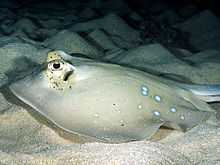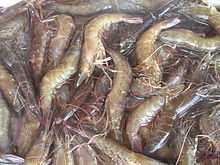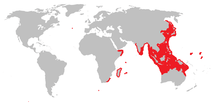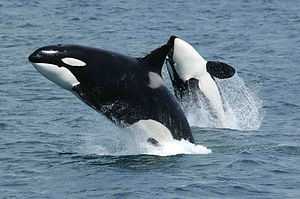Bluespotted stingray
| Bluespotted stingray | |
|---|---|
 | |
| Conservation status | |
| Scientific classification | |
| Kingdom: | Animalia |
| Phylum: | Chordata |
| Class: | Chondrichthyes |
| Subclass: | Elasmobranchii |
| Order: | Myliobatiformes |
| Family: | Dasyatidae |
| Genus: | Dasyatis |
| Species: | D. kuhlii |
| Binomial name | |
| Dasyatis kuhlii (J. P. Müller & Henle, 1841) | |
The bluespotted stingray (Dasyatis kuhlii) or Kuhl's stingray, is a species of stingray of the Dasyatidae family. It is light green with blue spots. Its disk width hovers around 42 centimeters (17 in). It is popular in aquaria but usually not distinguished from the bluespotted ribbontail ray. The ribbontail is rounder with brighter blue and more vivid spots, but the bluespotted stingray is larger.[1] The stingray's maximum age estimate is from one to eighteen years of age. The bluespotted stingray preys on many fish and small mollusks, but is also preyed on by the orca and hammer head shark.[2] The bluespotted stingray is also generally found in Indonesia to Japan, and south to Northern Australia. The bluespotted stingray is also targeted by many parasites such as tapeworms, flatworms, and flukes.
Taxonomy
The bluespotted stingray was discovered by Heinrich Kuhl in Java, Indonesia. The population of this species is greatly debatable due to the five different species of rays in Indonesia. Also, there are two different subgroups: the Java and Bali form.[3] The distinct difference between the two strains is their size, with the Bali being much larger than the Java.[4] On the familial level, the family Dasyatidae is made up of 9 genera and 70 species. The genus of Dasyatis are called maskrays, because of the color pattern around their eyes. The largest species of this family can grow up to 4 meters (13 ft).[5]
Description and behavior

The bluespotted stingray has a flat disc-like oval body in about 42 centimeters (17 in) in diameter and 70 centimeters (28 in) in length;[6] and their coloring is a dark green with blue spots with a light white underbelly also known as countershading. The bluespotted stingray's snout is very short and broadly angular along with its angular disc.[4] The rays' bright coloration serves as a warning for its venomous spines. The ray has a very long tail accommodating two venomous spines on the base of the tail. The tail is about twice as long as the body of the ray, and the barbs or spines are two different sizes, one being very large and the other a medium-sized barb. The bluespotted stingray has bright yellow eyes, and the eyes are positioned to allow them a wide angle of view. The spiracles, which allow them to breathe, are located directly behind the ray's eyes. The ray's gills and mouth are found on the underside of the body.[7] The ray normally lives alone or in small groups. One unique characteristic of the bluespotted stingray is that they rarely bury themselves in the sand only to hide from predators, unlike the majority of rays who bury themselves regularly.[7]

Diet
This type of ray feeds on shrimp, small bony fish, mollusks, crabs and other worms. Due to the fact that this ray is a shallow bottom feeder, it has a small variety of marine life to prey on. The bluespotted stingray overpowers its prey by pinning them to the bottom of the seafloor with its fins. This ray does not have teeth, instead it has food-crushing plates on the sides of its mouth.[7]
Reproduction
The bluespotted stingray is ovoviviparous. The embryos are retained in eggs within the mother's body until they are ready to hatch. The embryos receive nourishment from the mothers' uterine fluid. Mothers give birth to up to seven pups per litter; these pups range from 6 inches (150 mm) to 13 inches (330 mm) long at birth.[8] The bluespotted stingray passes its offspring 32 sets of chromosomes.[4] The mother also has an annual reproductive cycle. Studies show that the mating season is in October and November and the ovulating season is in the Australian summer (December 1- February 28/29), which coincides with the embryonic development.[9]
Habitat

The bluespotted stingray is commonly found in waters of depths about 0–90 meters (0–295 feet), being found near rocky coral reefs. This stingray is found in a tropical climate at 29°N- 31°S, and 20°E- 171°W.[4] At high tide the bluespotted stingray moves out into the shallow lagoons and reef flats.[3] It is found in northern Australia, Kenya, Madagascar, The island of Mauritius, Somalia, the east coast of South Africa, India. The bluespotted stingray is in almost the entire continental waters of Asia, including the Sea of Japan, Yellow Sea, East China Sea, Philippine Sea, Sulu Sea, Java Sea, Banda Sea, Celebes Sea, Andaman Sea, the Bay of Bengal and the Arabian Sea.[10]

Threats and protected areas
In Queensland, Australia there are many areas for high protection of the bluespotted stingray, three being the Shoalwater, Corio Bay's Area Ramsar Site, and the Great Barrier Reef Marine Park. A major threat of the bluespotted stingray is the destruction of coral reefs mainly in the Western Pacific. The rays dwell in these reefs and the destruction and pollution from fertilizers and pesticides hurt them.[7] The ray is commonly caught in the Java Sea by fisherman trawling and by Danish seine boats in large quantities. The bluespotted stingray is the second most significant species out of the sharks, rays, and skate family to be fished, contributing to about 700 kilograms (1,500 lb) per boat in 2006-2007.[11]

Predators
The hammerhead shark frequently preys on the bluespotted stingray... Also the orca is a threat, generally preying on juvenile rays. The rays coloration is a warning for the highly poisonous barbs, thus few animals attempt to overpower this ray.[8][12] The hammerhead shark uses its head to pin down the bluespotted stingray, while it is in shock and much weaker.[13] When an orca encounters a stingray they dig them up from the sand, then launch them into the air. Another strategy for subduing the ray involves the orca turning upside down, then biting the ray and flipping over, putting the stingray belly up and causing it to enter tonic immobility.[14]
Human interaction
Due to the unique characteristics of this ray it is very common to be found in pet trade, many people ignore the fact that in total maturity the size of the ray exceeds the capacity of many household aquariums.[7] The bluespotted stingray is generally fished for its meat, being either smoked and salted or dried for local markets.[11] It is caught in mass in bottom trawl, trammel, and fish traps. It is fished for its meat, but inexpensive due to small size.[4] The bluespotted stingray is very venomous and it has a barb approximately 12 inches (300 mm) long. The venom contains serotonin, 5' nucleotidase, and phosphodiesterase.[15]
The skin of the bluespotted stingray is often used for drums such as on the Arab and Turkish darbuka goblet drum and riq (def) tambourine.
Parasites
There are many parasites that inhibit the bluespotted stingray, this is a table of the common groups of the parasite, and the specific name of the parasite.[16]
| Common Class | Group | Parasite |
|---|---|---|
| Tapeworms | Cestodes cephalobothriidae | Cephalobothrium longisegmentum and Tylocephalum kuhli |
| Tapeworms | Cestodes mixodigmatidae | Trygonicola macroporus |
| Tapeworms | Cestodes onchobothriidae | Acanthobothrium bengalens, Acanthobothrium confusum, Acanthobothrium herdmani, and Acanthobothrium pingtanensis |
| Tapeworms | Cestodes phyllobothriidae | Echeneibothrium trygonis, Phyllobothrium ptychocephalum, Rhinebothrium shipleyi, Scalithrium shipleyi, and Scalithrium trygonis |
| Flatworms | Monogeneans monocotylidae | Dendromonocotyle kuhlii, Heterocotyle chinensis, Monocotyle kuhlii, and Monocotyle tritestis |
| Flukes | Trematodes monocotylidae | Prosorhynchus clavatum |
| Flukes | Trematodes didymozoidae | Didymozoid larva |
|
| |
|
| |
|
|
References
- ↑ (Randall 2005, p. 18)
- ↑ Jacobsen, I. P.; Bennett, M. B. (2010). "Age and growth of Dasyatis picta, Dasyatis annotata and Dasyatis kuhlii from north-east Australia, with notes on their reproductive biology". Journal of Fish Biology 77 (10): 2405–22. doi:10.1111/j.1095-8649.2010.02829.x. PMID 21155791.
- ↑ 3.0 3.1 "Dasyatis kuhlii". International Union for Conservation of Nature and Natural Resources. 2007. Retrieved November 28, 2011.
- ↑ 4.0 4.1 4.2 4.3 4.4 "Dasyatis kuhlii- Blue-spotted stingray (Müller & Henle, 1841)". FishBase. 2010. Retrieved December 30, 2011.
- ↑ "Stingrays (Dasyatidae)". WILD Fact Sheets. February 11, 2008. Retrieved December 24, 2011.
- ↑ "Species Fact Sheet-- Rays" (PDF). Shark Bay Ecosystem Research Project. Retrieved December 18, 2011.
- ↑ 7.0 7.1 7.2 7.3 7.4 "Blue Spot Stingray". John G. Shedd Aquarium. Retrieved December 18, 2011.
- ↑ 8.0 8.1 Bester, Cathleen (November 11, 2011). "Blue Spotted Stingray". Ichthyology Department, Florida Museum of Natural History.
- ↑ Pierce, S. J.; Pardo, S. A.; Bennett, M. B. (2009). "Reproduction of the blue-spotted maskray Dasyatis kuhlii (Myliobatoidei: Dasyatidae) in south-east Queensland, Australia". Journal of Fish Biology 74 (6): 1291–308. doi:10.1111/j.1095-8649.2009.02202.x. PMID 20735632.
- ↑ "Dasyatis kuhlii (Müller & Henle, 1841)". World Register of Marine Species. 2009.
- ↑ 11.0 11.1 "Dasyatis kuhlii (Bluespotted Stingray)". IUNC Red List. December 20, 2011.
- ↑ Pablico, Grace Tolentino (June 23, 2006). "Predator Summary — Dasyatis Kuhlii". FishBase. Retrieved December 27, 2011.
- ↑ "Hammerhead Shark". Aquatic Community. 2006. Retrieved December 31, 2011.
- ↑ How Whales Eat Sharks (television production). National Geographic TV. December 31, 2011.
- ↑ Auerbach, M.D., Paul S. (April 20, 2009). "The Tragic Death of Steve Irwin". Divers Alert Network. Retrieved December 31, 2011.
- ↑ "Host-parasite Database". Natural History Museum. November 13, 2011.
Bibliography
- Randall, John E. (2005). Reef and Shore Fishes of the South Pacific: New Caledonia to Tahiti and the Pitcairn Islands. University of Hawaii Press. ISBN 978-0-8248-2698-7.
| Wikimedia Commons has media related to Dasyatis kuhlii. |
External links
| |||||||||||||||||||||||||||||||||||||||||||||||||

